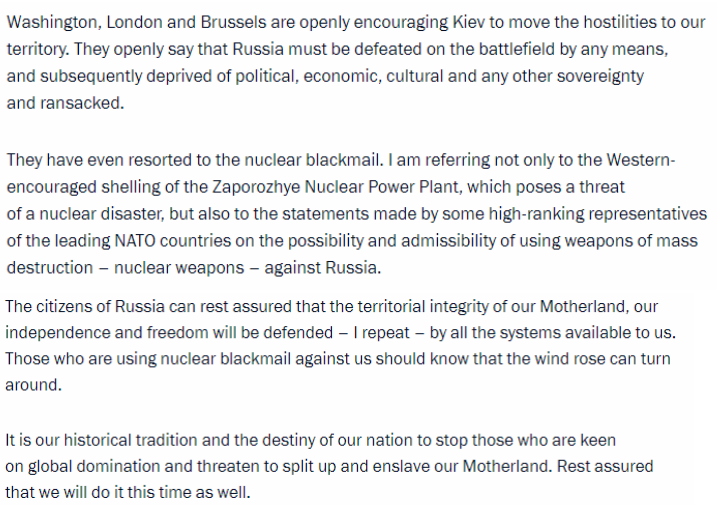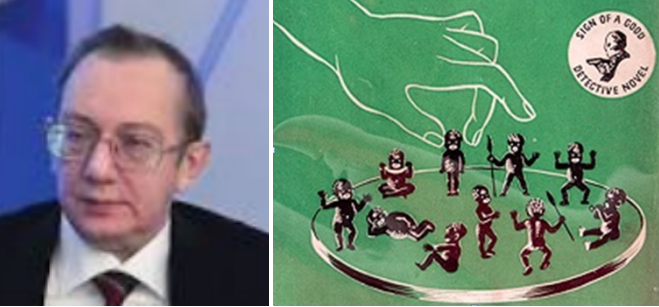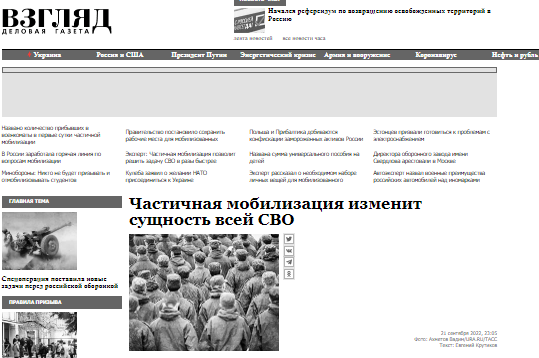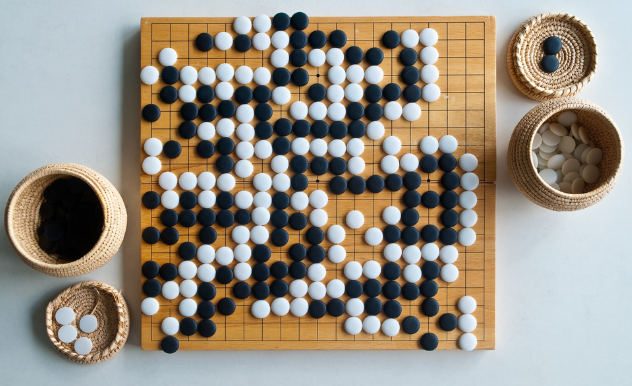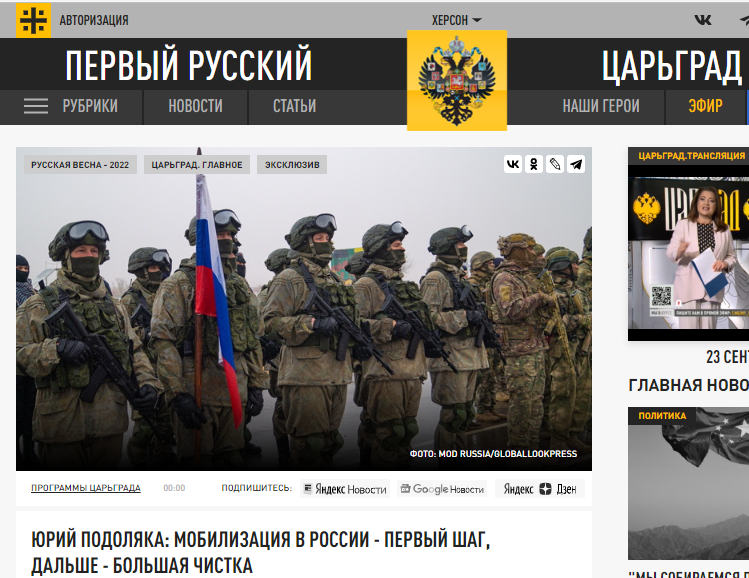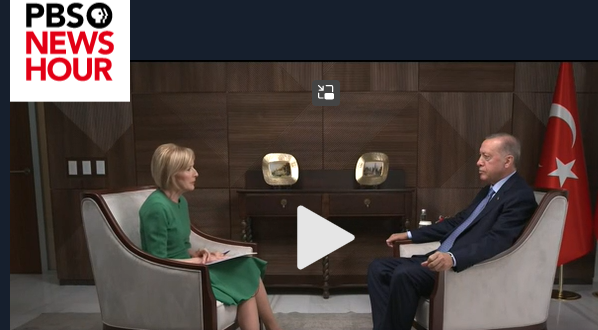Yves here. John Helmer provides commentary from Russian military experts on the partial mobilization. It appears that Russian conventional wisdom is that something like this was overdue.
By John Helmer who has been the longest continuously serving foreign correspondent in Russia, and the only western journalist to have directed his own bureau independent of single national or commercial ties. Helmer has also been a professor of political science, and advisor to government heads in Greece, the United States, and Asia. Originally published at Dances with Bears
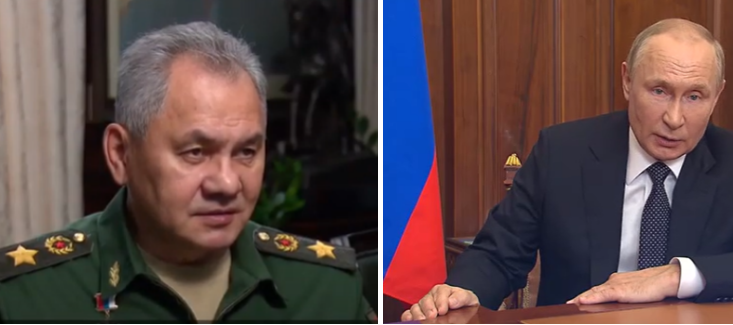
Agatha Christie’s whodunit entitled And Then There Were None – the concluding words of the children’s counting rhyme — is reputed to be the world’s best-selling mystery story.
There’s no mystery now about the war of Europe and North America against Russia; it is the continuation of Germany’s war of 1939-45 and the war aims of the General Staff in Washington since 1943. Defense Minister Sergei Shoigu (left) and President Vladimir Putin (right) both said it plainly enough this week.
There is also no mystery in the decision-making in Moscow of the President and the Defense Minister, the General Staff, and the others; it is the continuation of the Stavka of 1941-45.
Just because there is no mystery about this, it doesn’t follow that it should be reported publicly, debated in the State Duma, speculated and advertised by bloggers, podcasters, and twitterers. In war what should not be said cannot be said. When the war ends, then there will be none.
Counting down is what must be done in the meantime to distinguish between the phony war and the world war, between the propaganda and the truth of the matter.
Watch and listen to Shoigu’s interview, sub-titled in English and broadcast on national television on Wednesday.
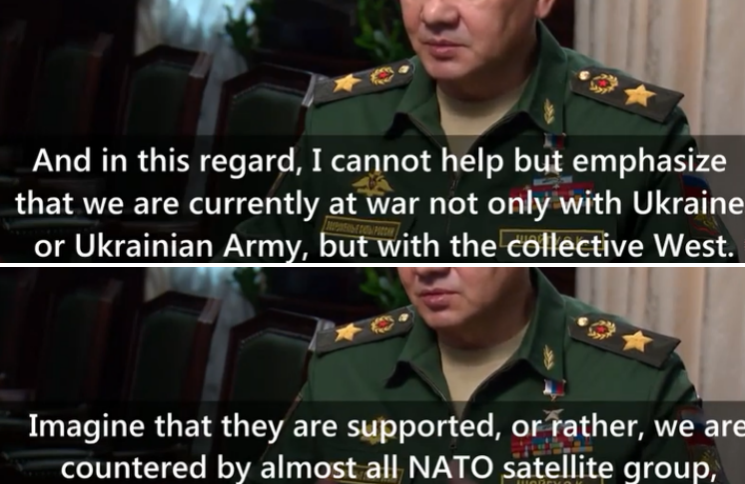
Click to watch Putin’s speech broadcast the same morning. Read the Kremlin translation into English by clicking.
Source: http://en.kremlin.ru/
Putin was replying to earlier nuclear weapons threats by British Prime Minister Elizabeth Truss in February and August of this year; and to German Foreign Minister Annalena Baerbock last December and again in May of this year.
Here are translations into English from published assessments this week by Yevgeny Krutikov, a former GRU officer and strategy analyst in Vzglyad; and Yury Podolyaka, a Sevastopol military analyst in Tsargrad. Their texts are reproduced here without editing or comment. Captioned illustrations and references have been added.
Left: Yevgeny Krutikov; follow his reporting here. Right, the cover design of the British edition of Agatha Christie’s story, November 1939. “I wrote the book after a tremendous amount of planning.” Christie said later. “It was clear, straightforward, baffling, and yet had a perfectly reasonable explanation; in fact, it had to have an epilogue in order to explain it…. it is a better piece of craftsmanship than anything else I have written.”
The partial mobilization will change the essence of the entire Special Military Operation
“What tasks will be assigned to those hundreds of thousands of new servicemen who will be mobilized to conduct a special military operation in Ukraine? There are several of these tasks; some of them are of fundamental importance. The force replenishment should change the very nature of the ongoing military operations in Ukraine.
In connection with the partial mobilization, first of all, one can find statements that its main task is to establish reliable control over the territories already liberated in Ukraine by the Armed Forces of the Russian Federation. Roughly speaking, this is a front-line echelon.
This implies a transition to defensive actions in the Nikolaev-Krivoy Rog and Zaporozhye directions and in the general Kharkov vector. To be sure, that is somewhat at odds with the plan of referendums in the Zaporozhye and Kherson regions, since they imply the entry into the Russian Federation of the entire ‘designated’ territory of the regions in the geopolitical form in which they are drawn on the maps of the Ukrainian Soviet Socialist Republic. Earlier, the same story happened with the DPR [Donetsk People’s Republic] and the LPR [Lugansk People’s Republic], which were recognized as states exactly within the old borders.
But right now it is very necessary to saturate the front with personnel. According to rough calculations, speaking purely quantitatively, the Russian Armed Forces and the [DPR and LPR] allies are lagging behind the standards accepted in military science — that is, the number of soldiers per kilometre of the front — by about four times.
Moreover, there is even more lagging in a number of areas, since in those zones where offensive actions are being conducted, the concentration of troops and means should be greater. Operational reserves are being pulled back there, and so in turn other sections of the front, where there has been a long operational lull, are weakening. At the operational staff level, something like the Japanese game of Go is starting; in this strategy game, one of the forms of offence is to numerically crush the enemy’s line by transferring all the stones there and surrounding him.
Source: https://en.wikipedia.org/wiki/Go_(game)
Google’s artificial intelligence programme has been winning its Go games against the Korean and Chinese Go champions. During the Vietnam War the Pentagon employed Scott Boorman, a Harvard student, to write an analysis of Vietcong and North Vietnamese Army strategy in terms of the Go board. Boorman won a Harvard prize for that; the US Army lost the war.
The enemy has long switched to the principles of total war and does not take into account its losses and the number of mobilized. The Ukrainian side has an almost limitless (for this theatre) mobilization resource, since they have no restrictions on conscription. The mobilization in Ukraine is total — the VSU [Ukrainian Armed Forces] is already taking the elderly, the seriously ill, even the disabled. In such conditions, the enemy can form what he calls operational reserves and throw manpower at the front line in endless attempts at counter-offensives.
This was one of the worst tactics of the wars of the mid-twentieth century, but the enemy is now using it, which means that it is necessary to react to it. Consequently, a significant part of the mobilized Russians should simply fill the front line with themselves, thereby eliminating the potentially dangerous numerical advantage of the VSU.
In the southern sector of the front, the front line goes straight across the steppe. There are far fewer settled points where you can be positioned than in the industrial and densely populated Donbass, where any settlement easily turns into a fortress. And now it is very difficult to create a full-fledged line of cover in this direction quantitatively. We have to take our positions in every locality in the same way as we have in the Donbass.
On the other hand, it is in the Donbass that we have to face the multi-layered defense of the Armed Forces of Ukraine; for cutting through that, the available [Russian] forces are also insufficient. The standards for the number of personnel required during the offensive and defensive operations were not invented at the top; they have been written in blood on the battlefield.
Earlier, some experts have talked about the possibility of forming an entire army corps in the Armed Forces of the Russian Federation from scratch. However, it is not customary to deploy and disperse the forces of such a large military formation. Therefore, this corps could only be used in concentration in one place. In other words, the new army corps was supposed to prepare for a major offensive operation, and not on the Donetsk sector of the front. Now is not the time to guess where exactly this could happen. The concept has changed, and most likely, it makes no sense to form any new large military units from scratch from the newly mobilized ones.
On the other hand, it is already clear that before being sent to the front, all the mobilized troops will undergo retraining. Since it is assumed that these are already experienced and pre-trained people, this will not take much time. The preparatory time will be spent on combat coordination. That is, ready-made crews (tanks, infantry fighting vehicles), calculations (artillery, MLRS [multiple-launch rocket systems], air defense) and vanguard units [разведчиков, literally ‘scouts’] will be deployed to the zone of the Special Military Operation. And such elements can easily be integrated into the already operational units, and thus they can be ‘sprayed’ all over the front. Especially where reinforcement is required in connection with the tasks set.
Specifically, the tasks assigned to the grouping will determine where and by what forces such reinforcement will be carried out. A group of about half a million people with modern weapons cannot stand still. Almost certainly, we should expect offensive activity from the Russian Armed Forces — much more intensively than has been seen in the past few months.
Consequently, another part of the mobilized forces, after training in combat coordination, should strengthen those units which will be included primarily in offensive groups. Such an increase in their numbers will pass unnoticed by the enemy, since there will be no change of units on the front line. The units will simply have new battalion groups. Such increase in numbers is almost impossible to determine visually and even electronically.
It is difficult to foresee which directions will be reinforced by the new territorial line of cover, and which ones will be prepared for the attack operations. Of course, there are obvious points — the steppe sections of the front must be strengthened unambiguously, as well as the areas of the north of the LPR and the Ugledar direction in the DPR). At the same time, no one has canceled the opportunity to continue the southern offensive on Nikolaev and Odessa, or north to Krivoy Rog.
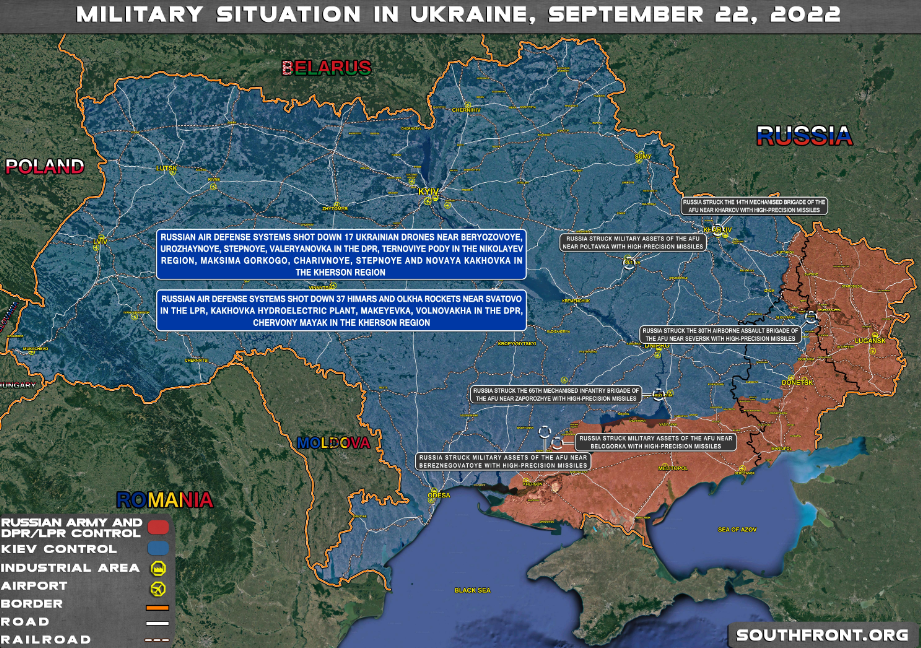
Southfront.org map based on the daily Russian Defence Ministry operations bulletin. For identification and enlargement of locations and reports, click on the link and scroll magnifier across the map.
There is another nuance, however. Given the tactics of the Ukrainian Armed Forces, it is vital to ‘turn off’ all long-range artillery systems and MLRS supplied to the Ukraine by the West, as well as all Ukrainian tactical air defense. These weapons are hitting civilian targets. This entire orchestra should be silenced. And for such counter-battery warfare, experienced gunners, drone operators, and special forces [разведчики] are required.
And, finally, another group of mobilized reservists may represent a possible logistical component. We are not talking about pure logistical [transport, supply] elements, but about new units which can carry out garrison service in the liberated territories. They should combine both police and security functions, and represent the same operational reserve of light infantry, which is usually missing just when it is needed.
This layering is, of course, provisional, since mobilization teams are to be formed for specific and designated targets. The objective is to saturate the front not just with a cover for territory but also to turn the grouping involved in its own kind of shock force – this is fundamental to the plan in which the share of the ‘specialists’ will increase significantly, if not exceed the number of ‘simple’ infantry. And this will change the very nature of the military operations.
First of all, the Russian Armed Forces will no longer be diverted by provisionally ‘weak’ – that is, less than quantitatively secured sections of the front. In addition, it will be possible to forget about the constant plugging of holes by transferring forces from one location to another. An operational reserve is about to materialize.
The planning of offensive operations will become regular, and several offensives can be carried out simultaneously on different sections of the front. And, finally, with the help of fresh reinforcements, the consequences of the use of western weapons, which in the last month began to prevail in the composition of the Ukrainian Armed Forces, can be stopped.”
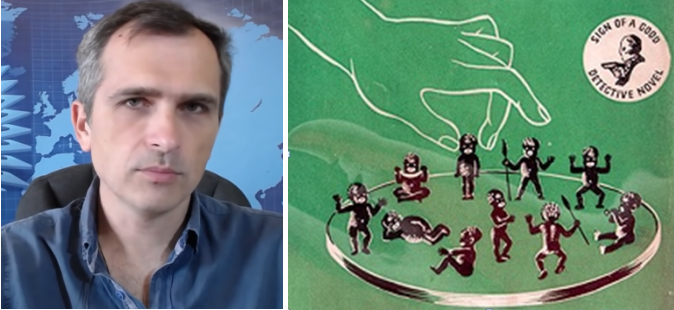
Left, Yury Podolyaka; right, the cover of Christie’s novel. Podolyak was born in Sumy, Ukraine; he moved to Sevastopol after the Kiev putsch in 2014. In 2019, he created a Youtube channel specializing in political and military topics; by March of this year his subscription audience had reached 2.7 million. For more, click to read.
Source: https://herson.tsargrad.tv/
Mobilization in Russia is the first step, then the great purge
September 22, 2022
By Yury Podolyaka
“Yury Podolyaka gave his forecast of the special operation in the light of the beginning of mobilization in Russia. He is certain that big changes are waiting for us, and they are connected, among other things, with a large internal purge of the political elite.
Everyone has been waiting for Vladimir Putin’s address for a long time. Many have held their breath. And so we heard the words of the President, who supported the decision of the citizens of the republics of Donbass and the liberated territories of Ukraine to return to Russia. And this means that Ukrainian aggression is now directed, not only against the republics of Donbass, but against Russia and Russians. And the Russian Army must go into battle.
This is the reason for the partial mobilization announced in the country. Under the banners, they will gather not inexperienced boys, but those who have already served and have military specializations. There is another feature — many of the restrictions imposed by the Special Military Operation will likely be lifted. And we will finally see how real blows will be delivered to the notorious ‘decision centers’ [Kiev, Lvov].
Question (Yury Pronko): How will the situation develop now, in your opinion?
Yury Podolyaka: As expected, partial mobilization was announced in Russia – there is no point in a general mobilization — such an army needs to be maintained, and now Russia is not physically capable of arming everyone. Thus, partial mobilization is somewhat different. New military units will be created. Here we can recall the recent decree of Vladimir Putin on increasing the size of the Russian Armed Forces from January 1, 2023.
Question: How would this happen?
YP: In accordance with the plans for the deployment of troops and replenishment of personnel, several hundred thousand conscripts will be called up for certain military registration specialties. Unit elements must be formed, not from just anyone, as they do in Kiev, but from specific technical experts who are part of the regular structure of a particular unit. Naturally, it is impossible to quickly recruit the required number of these people from volunteers. Therefore, a decision was made in favour of partial military mobilization and, accordingly, of the mobilization of industry.
Question: Do you concede that not only in the territory of the border regions of Russia – that’s to say, the Kursk, Belgorod, Voronezh, Rostov regions, and Crimea — but martial law may be declared throughout the country?
YP: Very had to believe, but I cannot rule out this possibility. This is because, in my opinion, the question of creating the State Defense Committee is already overdue and even overready. We now live under the laws of peacetime. Accordingly, we can influence certain structures, including state power and elected power, only through the laws of peacetime. Holding referendums raises the stakes and already implies a war to the bitter end, because neither Kiev nor the West will agree to the outcomes of the referendums. Therefore, everything will depend on the military, there will be no negotiations. The essence of the special operation must change – this is inevitable.
Question: Does this mean that the Special Military Operation itself will change in its essence?
YP: I really hope for it. I think it’s inevitable. Because it makes no sense to announce even partial mobilization within the framework of the Special Military Operation [SMO] – and this cannot solve the problem of a referendum. It is clear that the status of the SMO should be changed; this has been under discussion for a long time. If, nevertheless, martial law is declared on the territory of Russia, then we can expect the termination of the transit of natural gas through the territory of Ukraine and many other negative economic consequences. Right now I believe that strikes against the critical infrastructure of Ukraine should simply be unavoidable. And this will quickly put Kiev in an uncomfortable position. Military operations must now proceed differently.
Question: But do I understand correctly that there will be an escalation?
YP: Of course, this is the next stage of escalation, and at the highest level. The next stage is the direct and open declaration of war. Although the war has in fact already been under way. You can call this a special military operation as much as you like, but the essence of it will now change.
Question: Let me come at this from another direction. Even before the news about the decisions of the State Duma on amendments to the Criminal Code began to appear, even before the statements from the LPR, DPR, Kherson and Zaporozhye regions became known, President Erdogan made a statement in an interview with the host of the American TV channel PBS News Hour, Judy Woodruff. The Turkish leader said that President Putin allegedly wants to end the conflict in Ukraine as soon as possible. At the same time, Erdogan refers to a meeting with Putin in Samarkand. Is this just political rhetoric?
For the PBS transcript of the interview, click on source.
YP: Recep Tayyip Erdogan cannot speak on behalf of Vladimir Putin. He expresses his personal private point of view.
Question: That is the impression he had after the meeting?
YP: For God’s sake, let him do whatever he wants. Erdogan can only be responsible for Turkey and for his government.
Question: How do you think the situation will develop? You have already said that this is an escalation, that these are quite tough measures. I have a certain suspicion that Russian society for the most part is not ready for such a development of the situation. How to convey to people that this is important? That this is necessary — partial mobilization and the introduction of martial law?
YP: We woke up on February 24 in a completely different country. It’s just that people still try not to notice it. But this is to be expected, really. After all, both at the beginning of the First World War and at the beginning of the Great Patriotic War, people also did not fully understand the essence of the events that took place at the beginning. And even the leadership of the Soviet Union finally designated the Great Patriotic War as the Great Patriotic War only on August 10–11, 1941, and not on June 22 at all. It’s the same with us now. The war is already underway, and we have had another country since February 24. In gradual steps our society should mature to understanding. And yet we are not going anywhere else. The country will be different. The world will be different. And we, accordingly, must win our place under the sun in the new world for our country. There are no other options. If we do not do this, then we will be in the dustbin of history.
Question: What will this mean from the practical point of view of our compatriots, ordinary Russians?
YP: In fact, for the ordinary person, nothing fundamentally will change, not yet. But the rules of the game in the country will change. That is, many things that could still be done – to criticize the special military operation, to criticize the army, to express, as some say, ‘their personal opinion’ about these events which harm Russian society — all this will gradually be curtailed. It is clear that you cannot conduct military operations when a powerful fifth column is fighting against you in the rear. This, first of all, the ordinary Russian will have to understand.
There is one more problem. Many officials are waiting for everything to come back to where it was in the expectation that the Russian army will lose in Ukraine. I feel and see it when I communicate with people. And I really hope that after Vladimir Putin’s address, all this will stay in the past. Each official will be subject to completely different requirements. They will either have to support what is happening, or they will be removed from their places.
Question: So you are convinced that the behaviour and thinking of the so-called elite will change?
YP: Not right away. But things will change very quickly. However, the mobilization will affect a very small number of people. It will be no more than a few hundred thousand people.
Question: I understand what the transition to the mobilization model of the economy means. However, I have very significant doubts, taking into account the structure of the domestic economy, taking into account those owners who control the assets. I am skeptical that this entire group will begin to change. What do you think the mobilization economy means?
YP: The mobilization economy can be different – full, partial, and so on. I do not think that the same emphasis will be placed on this now as it was in the Soviet Union in 1941. That is, everything for victory, and nothing else for anything. However, the production of weapons will be increased; we will see some changes in priorities. We urgently need to make ourselves independent now, including in the information space, in the computer business. And if earlier we tried persuading the asset owners to do this, now we must compel them by state order.
Question: Why didn’t we switch to domestic software?
YP: Because, frankly, it was inferior and more expensive. But now I am waiting for solutions that will make it easier for us to make the transition to an independent economy.
Question: Do we have enough strength, do we have the resources, in your opinion? If you understand that backing the Kiev regime is the entire West. And here we are, how many of us are there? There are just so many of us, and no more than that.
YP: In point of fact, it’s not the whole West. The West shows that Kiev is just a tool for manipulation. But the West is not going to fight for Kiev to the end. That’s already obvious. Yes, the West is helping Kiev. But, firstly, not everyone is helping, so the West is quite disunited. And not everything they do is as fine as some of our propagandists paint the picture.
Question: Where is the line after which we can say that we have won?
YP: The state of Ukraine should disappear from the map. That’s when it will be a victory. I think two-thirds of Ukraine should be ours. This is somewhere along a line to be drawn between Zaporozhye and Vinnitsa.
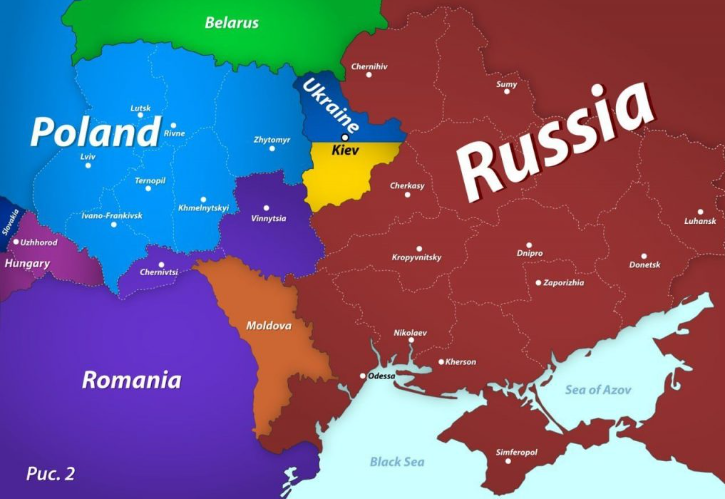
“The Medvedev Map” was posted by former Russian President, Dmitry Medvedev, currently deputy head of the Security council, on July 30, 2022.
Question: When can this happen?
YP: I believe that hostilities will last the whole of 2023. Before then this war will not end. ”

